Cuba Communist Accounting IV: Cuba Prices from Housing to Bread to Ration Books
Part of the Cuba Communist Accounting Series:
I Cuba Communist Economy Today
II Particular Accounting – Hot Convertibles, Top Professions, and Trickle-Around Economics
III Taxing Casa Particulares and Cubans
IV Cuba Prices from Housing to Bread to Ration Books
V Traveler Memoirs of Econ-o-Caphony, Anachronism, and What’s Good is Bad
January 2017
Sections:
Crowded Grocery Stores, Low Variety, Empty Shelves
To Make an Italian Meal in Cuba
Price Comparisons Versus Purchasing Power
Cost of Living in Cuba
50X More Earnings (consumption) in the United States, yet people 2X happier in Cuba?
Pricing Guide To Cuba
How Do Cubans Eat (and party) @ $2 a day “poverty”?
Trade Routes and Pricing (USA to Cuba purchasing recommendations)
Trade Routes for Social Profit Motive
Intro
In my vein attempt to try and cook dinner for my hosts at the casa particular, a Cuban home I was staying in for $25 a night, I was onto my third store. While writing this piece I had quickly exhausted all the household coffee and I felt bad about it. And I needed more… Also I was almost out of money and my Visa cards were summarily rejected from every ATM on the island. It had only been about two years since any US based bank cards could be accepted in Cuba and seemed like they effectively were still banned. I had accumulated what I could in the early evening from street vendors: 10 pounds of onions - $3.45, a bunch of very modest flowers $1.15, and a bottle of Chilean red wine $6. I was not only on a mission to cook, but to find out how the prices compared to the United States. To make such a comparison meaningful, I will reference Cuba Communist Accounting II: Hot Convertibles, covering average wages for a little as a dollar a day. Finally, I offer Trade Routes – A buying guide for pleasure and hypothetical profit when traveling to in from Cuba and the United States
Crowded Grocery Stores, Low Variety, Empty Shelves
I worked my way up from street vendors selling onions to flowers to the larger markets located in one of the larger Habana, Cuba malls. Supply and demand issues were clearly apparent by empty shelves and stocking boxes strewn about as employees quickly moved to restock items. The variety was bleak compared to what I consider to be the miracle of US capitalism: grocery store variety. No fresh vegetables and nearly all meat was frozen. No US direct products were in sight, although some likely were derived by US global corporations delivering from non-US destinations. Sneeky.
Vegetables were absent from the store, most likely because they are readily available from street markets and vendors for excellent relative pricing. Combining ration coupons and vegetable open markets can create a rather healthy and affordable plate. Quality meat remains a hot commodity, much more affordable in the countryside. Most families get the occasional opportunity for a fresh caught fish or slug of meat due to some windfall work that is then shared. Processed pork and chicken products are also affordable a few days a week for the average family.
As for the crowds, I attribute to a combination of inefficient store layout, checkout and purchase process, and the lower purchase volumes. The butcher both packed meat and checked people out behind the meat case, blocked by the meat selection / checkout line. Packaging was strange as only five pound coffee bags were left, yet individually packed hamburger patties were available. I witnessed one man purchase four pieces of cheese and 3 ham cold cuts at the deli counter. This comically reminded me of a time in college, but for this gentleman – this economic predicament was a daily reality - complete with a large Styrofoam container, cellophane wrap, and plastic bag. Imagine the lines in a US grocery store if everyone only bought one thing at a time. Costco and equivalents are operating at mass economic efficiency, so that a minimum purchase is its own miniature economy of scale (enjoy the contradiction).
And the empty shelves… images that appear in the United States only after a hurricane or similar natural disaster comes through. But in Cuba, especially when a free government subsidy like the customary 3 OZ of meat per month is requested, the supply does not always (rarely) meet demand. The block long bread lines of yester-year communism may be gone, but supply issues remain.
To Make an Italian Meal in Cuba
I failed at compiling the necessary ingredients to make my Italian dinner. When trying to buy garlic, I would have had to buy twenty cloves at a time off the street – to I bought ten pounds of onions. Switching loyalties, I figured, perhaps I could make French Onion Soup. Wine – surprise – I got that, along with some decent, slightly slimy, monchego cheese at US prices. Steak can be quite pricey in Italy, but in Cuba, is practically non-existent. My non-expert conclusion is that communist principles are engrained in the blood of the Cuban people in there semi-private “particular” businesses – as well as perhaps in the laws. Prices seem strangely fixed and when it is out, it is out.
Classic “invisible hand” economics would allow beef prices to simply float up when supply is tight and demand rampant. If some crazed American should be hell-bent on paying for a $90 at-home steak dinner to please his hosts, well, let’s do it. But this is Cuba. I cannot buy coffee even at the grocery store, let alone glutton free pasta. And the present situation, January 2017 is likely one of the largest variety and abundance of goods this island has ever scene.
Price Comparisons Versus Purchasing Power
To say that things in Cuba are about the same price in the United States, is not a wild statement, but neglects the relative purchasing power of the individual citizen. Ya, Cuba has cheap tobacco and sugar (rum) – after all – the cultivation of the aforementioned were primary drivers of colonization. And when we look at some commodities like gas, chicken, cooking oil, and flour – maybe similar to American prices – BUT this must be taken in context that the average Cuban family makes, maybe $1,000 a year including government subsidies in the equation. And if we assume that the average American makes $50,000 a year, well, there ya go, America is living at 50X economic output.
How does GDP by the book stack against my back of the napkin calculations?
Cost of Living in Cuba
Most Cubans have no rent payment and certainly no mortgage. Three generations sharing a rather crumbling structure is the average big family (small) home. Yay, no rent! It does not take an economist to figure how little rent would cost if you crammed ten Americans into a two room apartment. No rent, therefore is hugely significant to comparing overall costs of living, however, I would contend that most Americans largely live alone or with their nuclear family by choice, regardless of US perceived “economic hardship” that paying a large rent compared to income creates (think big cities).
50X More Earnings (consumption) in the United States, yet people 2X happier in Cuba?
Does earning equate to happiness? Chickens in the street, stinky cars, bumping speakers fifteen hours a day, loud live music, and babies wandering between the neighbor’s house is the stuff of nightmares for your “Average Basic” American. This is Tuesday in Habana. This culture does have many visible issues beyond basic annoyances. Freedom of speech, poor dental care for the elderly, and lack of access to “advanced” medicine certainly has contributed to some missing teeth and occasional missing limb. Yet, the US has these same issues.
Happiness is highly correlated with community and family (my opinion) – both of which seem to be a strange offshoot of the real suffering caused under the rule of Castro in the form of hunger, repression, and worse. However, perhaps in our perceived madness of the regime, we neglected the strange bonding effect that such scarcity created. Statistics of Gross Domestic Product (GDP) of a communist nation are sketchy enough, who knows about other “happiness indicators.” Cuba is both rich and poor in life and capital, which is further explored in Cuba Communist Accounting V: Memoirs. No I am not writing this with a Che Guevera hat on, cigar in mouth, and rum in hand, however tempting that all may sound. Point being, that in this accounting and economic analysis, that I urge the reader to keep in mind other intangible facets of in otherwise poor nation – low crime, high birth rates, cultural mixing, high literacy, and of course – Che Guevara hats, cigars, and rum.
Pricing Guide To Cuba
The US government has vast amounts of pricing data on everything from fuel to milk. My pricing data centers around the basics, like a beer. Which! Also should be taken in context whether consumed at a restaurant or a supermarket. In several countries I am often surprised to see how food and beverage consumption pricing in the supermarket is similar to that in restaurants and bars. Translation: as a traveler in Cuba, you might as well just eat and drink outside for your vacation. Talking real food and drink, I can easily justify the cost of “eating out” to be 5X that of “eating in” – whereas in emerging economies it might be a 2X ratio, or even the opposite when you do not have a home to cook in. Drum roll please… here is some selected pricing wildly estimated, however, statistically / contextually relevant in my opinion. Also included are the monthly rations as they are still an instrumental part of Cuban life, especially for lower income families.
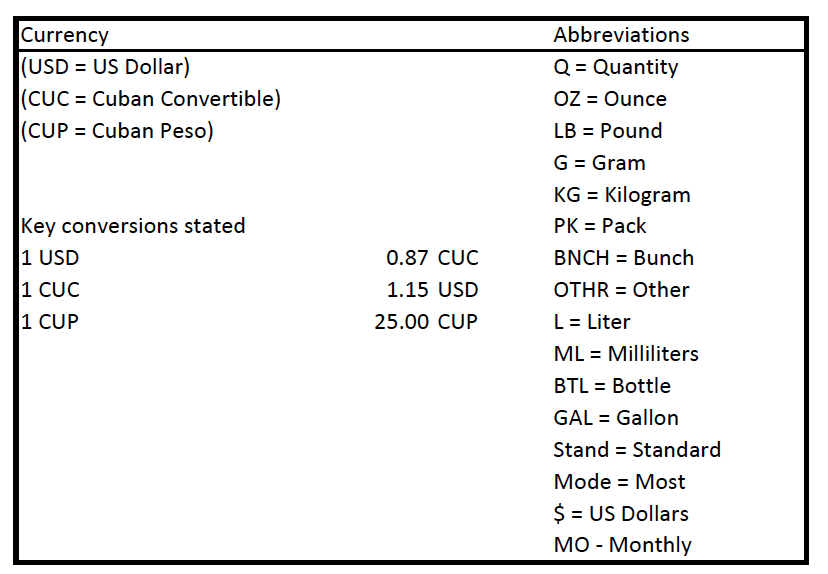
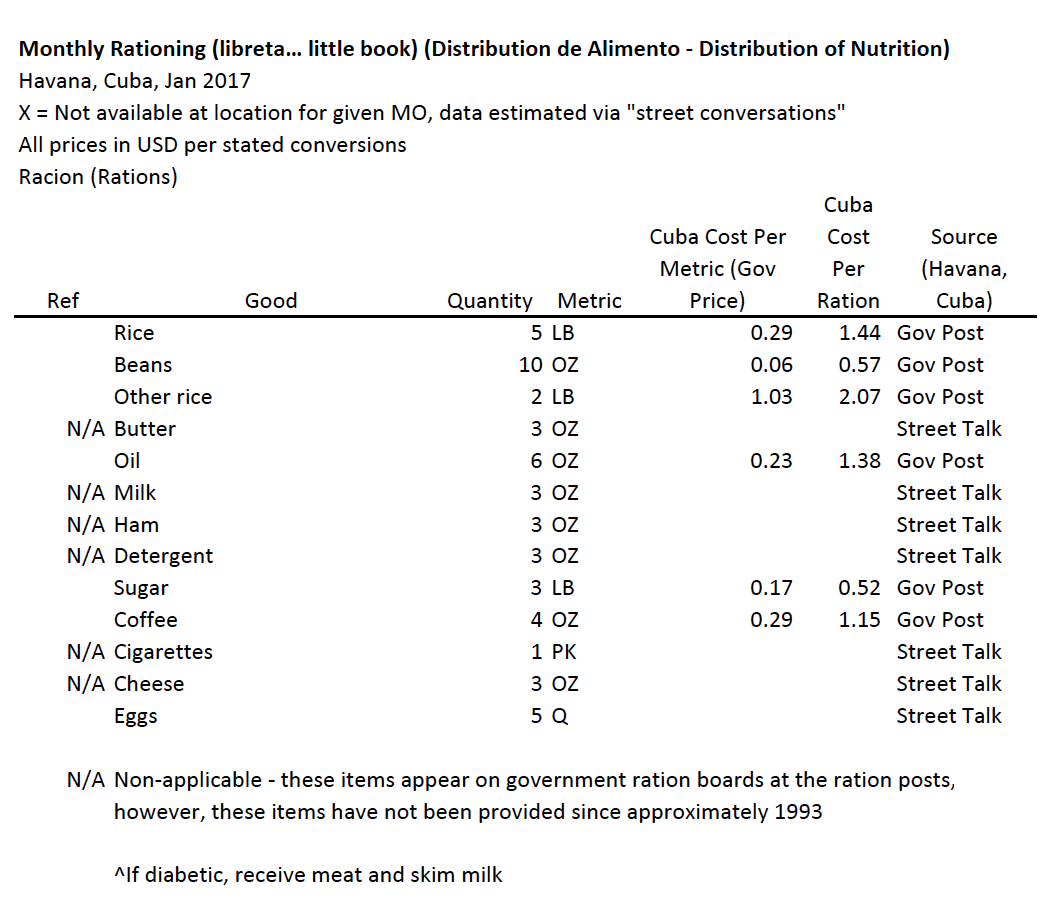
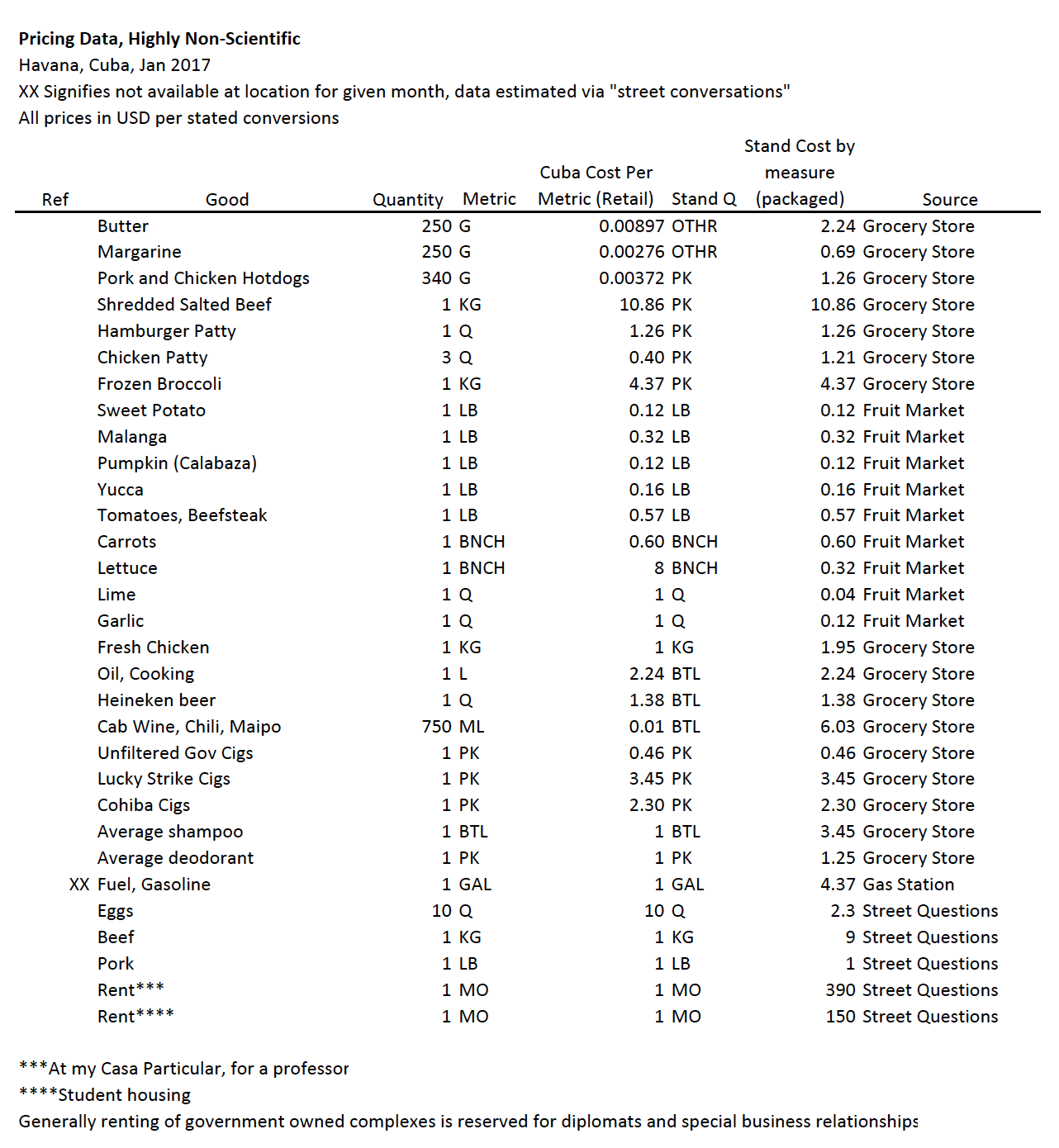
How Do Cubans Eat (and party) @ $2 a day “poverty”?
Cubans get enough calories in this period. The government subsidy, as well as highly localized fruit and meat markets offer enough good calories to keep on muscle and allow for an average pot belly. It is a good look mostly, compared to the highly refined corporate food rapidly fattening other emerging economies. Take some rice and beans, add a few fried plantains, dash of salt, taste of coffee, sliced onion, tomato, lettuce, juice, and there – you are eating better than most. “Fast-food” and all the associated trappings of our USA “rich” and highly diabetic culture are mostly absent from the Cuban culture. In Havana, there is certainly access to high sugar content beverages and fried food absent of much useful nutrition, aka, empty calories.
Locals also have access to local “hooch” rum that may fill empty water bottles for as little as $1 a liter. I past for fear of esophagus burning and potential blindness. Along with $.75 cigarettes and three for $1.25 condoms, those seeking or addicted to life’s vices are well satisfied for cheap. Other drug use appears to be simply unaffordable, not worth the potential penalty, nor is of mass interest. I don’t see a culture of public drunks or addiction driven crime, which is overtly visible in the streets of the United States most expensive cities, such as San Francisco and New York.
Parties seem to be everywhere with wonderful live music available more or less to those who want to find it. Plaza restaurants in Habana have ten person bands which fill the public space with rich, delightful sound. Should the neighbors have speakers, you bet they are used. On the street level, houses are mostly open and inviting with locals enjoying a sip of rum or beer in the street. What clicks and animosity boils under the smiles I do not know, but ultimately everyone seems to have a bit of fun.
Trade Routes and Pricing (USA to Cuba purchasing recommendations)
Global price differences are exciting and should be exploited! Such exploitation may seem like ripping off locals at first, but following the almighty supply and demand curve – such an exploiter, such as Christopher Columbus or your average Dutch colonizer is simply smoothing out curves, albeit aggressively for our modern tastes. Loosely I refer to modern Trade Routes as the potential to hypothetically profit from such price differentials by buying low and selling high – or in reality – my preferred trade route, buying low and consuming high. This is the concept of Duty Free, only amplified by technology.
Don’t bring sand to the Sahara desert, nor ice to Eskimos: Don’t bring rum to Cuba, nor corn to the United States. Why? Because Eskimos deal with enough ice already and Americans don’t need any more corn. The idea behind knowing what is scarce to others in different countries is to provide a new experience for them. Below are some ideas based on the pricing data I have casually gathered, combined with my highly empirical travel experience in and out of Cuba. Generally items to bring are very difficult, if not impossible to find. The general idea is pretty easy – bring the people some good stuff and you might even be treated better for it.
In General:
-Perishables are generally sketchy due to agricultural laws and not worth bringing
-Cubans have been banned from anything American for quite some time, so nearly anything will be value, even if lightly used
What to bring to Cuba:
-American / European candy – large or individually wrapped – think Snickers, Jelly Belly, and even something as boring as M&Ms
-USA Whiskey
-Expensive alcohol such as 100% agave tequila
-Champagne / Sparkling wine is generally a crowd pleaser
-Gourmet cheese… although difficult, would provide a fabulous gourmet experience
-Chocolate chip cookie and brownie mix
-Any electronics, the more expensive the better – Apple stuff especially, perhaps used iPhone 5 could be a sweet spot, USA plugs work great – also could try just old i-pads or i-pod touch (color with camera)
-Old digital cameras could be highly valued – this paired with say, a basic old PC could change someone’s life
-Clothing is scarce and lightly used clothing from the Goodwill would be highly valued
-Fancy IPA style, American craft beer
What not to bring to Cuba:
-Any tobacco products
-Rum, or non-American basic alcohol like vodka
-Inexpensive South American wine
-Warm coats or warm anything
Trade route Cuba to USA ideas (check current local agriculture and custom laws):
-Rum, Cigars, Coffee, Honey… I recommend consuming all at the same time
Trade Routes for Social Profit Motive
A general strategy is to maximize the amount of giving in the context of USA prices and baggage handling within legal reason. If there was a profit motive, I would select extremely low priced, high margin goods – such as phone chargers. But again, “people just don’t have money.” En-masse, such giving could be seen as “handouts” and yes, they are – but when being hosted by someone in their house – it is really just a tip and motivator to continue building global economic, social, and other relationships.
Ordinarily I would recommend goods high in demand and generally expensive if you were to somehow legally sell goods from abroad (clearly illegal in Cuba and most other countries). But for the US to Cuba route, I would see it more as aid. If you are into say, Cuban cigars, however, here is a place where certainly if you could re-sell them in the USA, you could gain a bit of profit. Again, I see the legal gifting of such items to be of equal or more value in the context of personal and business relationships. You can be assured my suitcase will be packed to the legal limit.
Conclusion
Prices in Cuba, as with any other country are different relative to comparative exchange rates – which can make traveling fun or frightening depending on what side of the currency and economic coin you come from. Prices when taken into account other factors like local earnings, job availability, and public services take on an entirely different dynamic which suggests some countries can have a “50X” living standard as compared to another – however – these metrics largely neglect other fundamental human needs such as love, happiness, and freedom – two of which are seemingly abundant in Cuba.

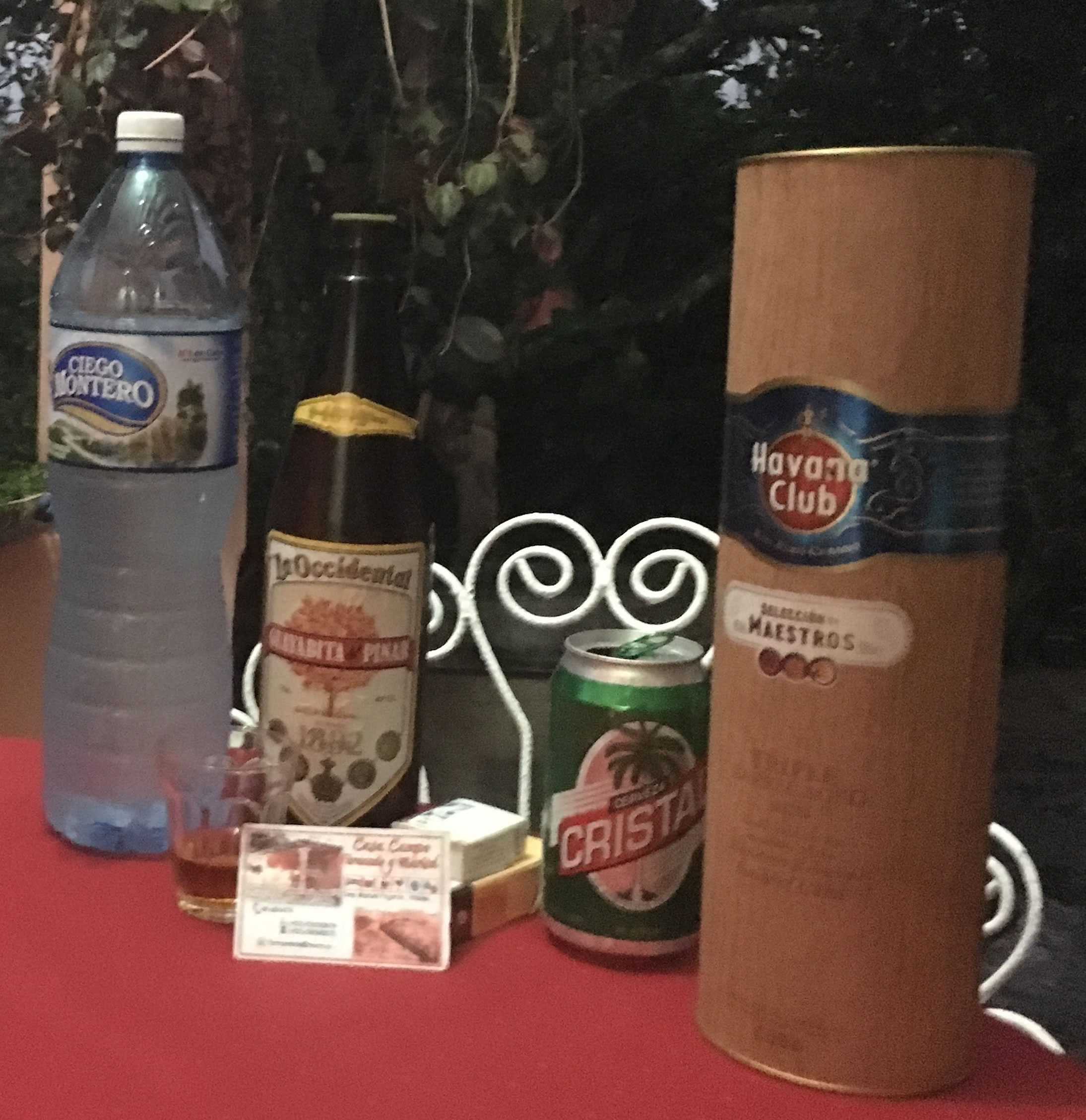


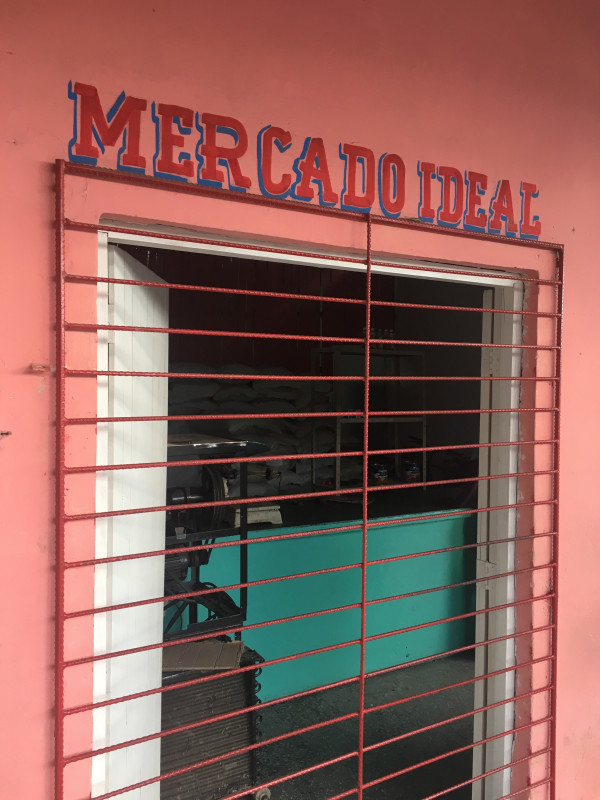


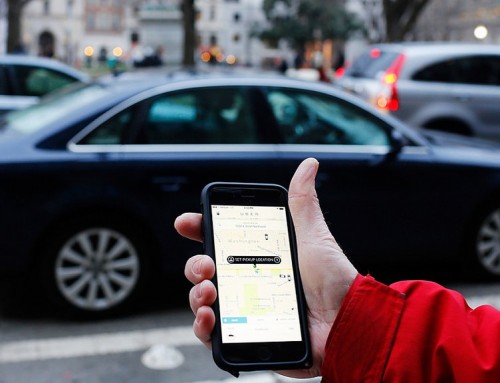

Leave A Comment